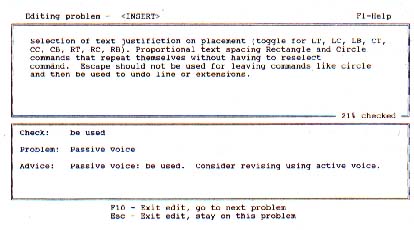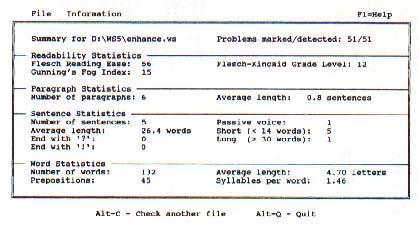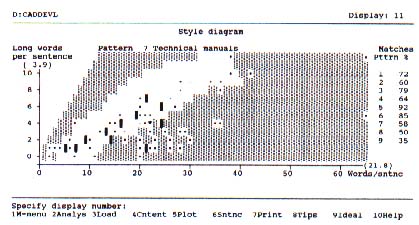Mac and PC On The ST
Readability and Grammatik III
Under pc-ditto
BY DAVE EDWARDS
There are several grammar checkers available to help out the word-weary writer. Unfortunately, most of them run on the PC and clones--the poor ST user is left out in the cold. In fact, I purchased a PC clone just to use these programs. However, with pc-ditto from Avant-Garde Systems, ST users now can run many of these programs.
After writing a piece, first I check it for spelling and then I run it through Grammatik III from Reference Software. Grammatik III interprets a text file and assigns the part of speech to each word. Then it determines whether you have made any grammatical errors. Considering the complexity of the English language, this program does an amazing job. It's not designed to turn bad writing into good, but to help you become a better writer.
Naturally, the program runs very slowly under the current pc-ditto (but it's not too bad since it's a text-based process). Grammatik III uses standard pull-down menus that you select with a [Alternate]-key combination. However, it can only read WordPerfect and straight ASCII files. I use ST Writer and normally print my file to disk, which works fine (Editor's note: If you use ST Writer, Word Writer or 1st Word, you can convert them to WordPerfect format using WordPerfect's conversion utility or S.I.F.T., the START Instant File Translator, published in the May 1989 issue of START.)
Grammatik III uses several word and phrase dictionaries to determine your errors. Once it finds one, an edit window appears showing the portion of the text in error, the error type and a suggestion for correcting the problem (see Figure 1). You can make the change right in the editing window or you can flag the error to correct it later.
Once the entire document is checked, Grammatik III will give you a report (see Figure 2). The first section shows the readability indexes. These are standard values that give the grade level required to read your document. Grammatik III's manual has a complete explanation for each number. Also included are your sentence statistics and word count, which help you get your document to the desired length.
 |
| Figure 1. Grammatik III uses several word and phrase dictionaries to determine your errors. Once it finds one, an edit window appears showing the portion of the text in error, the error type and a suggestion for correcting the problem. |
How Well Does It Work?
I've found that Grammatik III doesn't catch everything and sometimes flags errors that aren't really errors. The program doesn't correct problems for you--you must do that yourself. After using it for a while, I noticed that I kept getting dinged on passive voice--a common problem for writers. So instead of just correcting the problem every time I dug out the grammar books and learned how to prevent the problem.
More importantly, I found that sometimes I'll mistype a word-which turns out to be another word, correctly typed. Grammatik III will find many of these errors because the new words don't fit correctly.
The program flags many errors such as verb agreement, punctuation and even capitalization problems. It also uses a phrase dictionary to flag words or expressions that are not proper. You'll see errors such as "Hackneyed, cliche or trite" or "Pretentious or overstated." Fixing these problems makes your text much easier to read and less cute or pompous, whatever the case may be.
 |
| Figure 2 Once the entire document is checked, Grammatik III will give you a report. The first section shows the readability Indexes. These are standard values that give the grade level required to read your document. |
One of my habits is that I use the word "that" when I don't need to. Using Grammatik's phrase editor I added the word "that" to the phrase dictionary and asked to be prompted every time the word comes up. You can do this for any phrase or any phrase combined with other parts of speech. As Grammatik checks your document, it assigns parts of speech. You can list this interpretation if you like and see what the program has assigned to what. Using this information you can set up your own special cases to have flagged. It's complicated, but it helps tailor the program to your particular writing problems.
If writing is a big part of your life, then I suggest you buy this program and use it. Your teachers will love you, your bosses will love you, even your editors will love you.
Readability
Readability from Scandinavia PC Systems takes the last section of Grammatik III and builds on it. The program determines how easy it is to read your document and flags any sentences that need to be simplified. It uses an analysis pattern type such as Children's Book, Technical Manual or even Bureaucratic. It then reads each sentence to determine how well it fits into the chosen pattern. This information is shown in over 20 charts (see Figure 3).
Each sentence is represented as a dot or bar. Sentences that fall into the clear area are suited for the type of document chosen. Those that fall in the gray area are outside that range. On the right of the chart are percentages telling you how close you are to the readability required. For pattern 7, Technical Manuals, this review is at 58 percent. However, it is 92 percent at pattern 5, Novels. This probably means that this particular piece is a little simple for a technical manual--not that that's bad; it just means that I could have used harder expressions and the readability would still be all right.
 |
| Figure 3 Readability determines how easy it is to read your document and flags any sentences that need to be simplified. Each sentence is represented as a dot or bar. |
Readability is a little harder to explain and much more subjective to use. The program calculates "glue" words to "bricks:" Glue words are the smaller words needed to hold a sentence together, whereas bricks hold the meaning of a sentence. It tells you if you're using overly long words too often. The program has several charts showing the readability level of each sentence and gives other percentages. It also makes suggestions when you fall out of your chosen range.
I found no problems running Readability under pc-ditto but, again, it was quite slow. I know things will change when pc-ditto II arrives, however.
Grammatik III and Readability are well worth investigating. They've helped me out of jams at deadline time--or when an editor needs an article "yesterday." I highly recommended both programs, but remember that they're tools--not easy ways out.
Dave Edwards runs a CAD consulting service and has written several CAD-related articles. When he is not writing about CAD, you will find him doing VersaCAD training. He is also a MIDI consultant, professional drummer and managing editor of "The MIDI Insider, The MIDI Power User's Newsource."
PRODUCTS MENTIONED
Grammatik III, $99 Reference Software Inc 330 Townsend Street Suite 123 San Francisco CA 94107 (415) 541-0222
Readability, $94.95. Scandinavian PC Systems, 51 Monroe Street, Suite 1101, Rockville MD 20850 (301) 294-7450